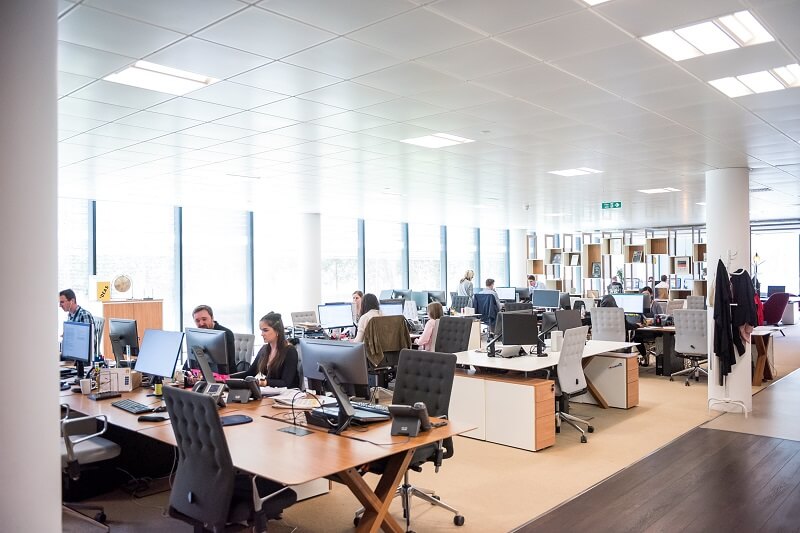

As workplace sensor technology becomes more pervasive, we readdress the delicate balance of benefits vs. privacy.
Earlier this summer, we heard of a Wisconsin-based tech company ‘microchipping employees’ to enable contactless access to buildings, computers and even cafeteria purchases. And while the thought of a rice-sized RFID chip implanted under the skin may sound like a sci-fi nightmare to some, others seem to be embracing it. Almost two-thirds of the company’s workforce volunteered to be chipped. This just goes to show how identity linked sensing technology is very much on the rise in the workplace.
It may sound like an extreme example, but it is far from the only one. Colleague finding apps, GPS monitoring tech and other ‘people analytics’ tools have been making their way into the world of work for some time now, usually in the name of productivity.
However, privacy experts raise serious questions over the security of these technologies and how they could be used to track how long employees spend on breaks or in the bathroom for example. It’s a delicate and emotive issue, especially where ‘monitoring’ comes into play.
Risk aversion vs. reaping the benefits
When it comes to occupancy measuring technology – i.e. sensors that monitor the use of office space – there is a fear that the tech might damage staff morale or lead to reputational risk.
Indeed, cases where sensors have been installed in workplaces without employees’ knowledge have created media firestorms in the past. The issue here however is not the sensors themselves, but rather a matter of data privacy, purpose and of consent.
Sensors carry numerous benefits. Many blue chip organisations, including those in typically risk averse industries such as financial services, have used them to benefit employees, improve their productivity, visualise space availability and step change employee engagement.
The subtle difference is to ensure how technology can be deployed in flexible spaces where personal identity is not relevant or applicable. Moreover, employers can demonstrate their disinterest in personal tracking by only installing products that do not require log-ins or user identification.
The purpose of using sensors must be to characterise spaces, not to monitor individuals. Providing timely and valuable data about flexible workspaces can not only help staff have happy and productive days at work, but also serve to improve overall property utilisation.
Who can benefit?
Businesses that would most benefit from this technology include those moving into a new flexible space, those experiencing space related HR issues such as dissatisfaction and poor productivity and those planning to reduce real estate without negatively impacting staff.
The design of the solution has to take into account the business’s working culture. Offices are structured differently from one organisation to another, and even within different departments of the same company. Some offices may have tight-knit teams that need to work in close physical proximity, while others may be open to fully non-addressed seating.
These aspects must be considered, both when selecting a technology provider and when setting up the solution in situ. Not all space needs to be monitored after all, and the ideal set-up will need to be highly bespoke.
Versatility is a critical success factor of this technology as it must be adaptable to a variety of non-allocated working spaces such as meeting rooms, solo working and collaboration areas. What’s more, hardware with the in-built capability to measure environmental factors such as temperature, humidity, light levels and air quality will add more to the user’s overall experience and provide facilities and real estate teams with valuable insight.
How to make the most of it
In order to get the most out of a sensing platform, a carefully communicated change management programme is essential. Using clear language to express how flexible spaces are supposed to work, the change management team should set unambiguous expectations and ensure people’s questions are addressed early in the process.
In addition, and perhaps most importantly, the senior management team within the organisation must demonstrate their confidence in the efficacy of the solution and be seen to be embracing it themselves, or leading by example. By doing so, they will show their commitment and inspire trust and buy-in from their employees.
One of the key, and in fact most important, measurements of success for the deployment is employee satisfaction. Has the system been easy to use, have staff seen benefits such as reduced time finding working space and an overall improved office experience? The crux of this technology is to make workspaces better, with the added bonus of reducing real estate costs, so if staff are happy then it’s clear the solution is working.
At Workplace Fabric, we have seen corporate users benefit from our Freespace solution by delivering space utilisation increase by almost 30 per cent. Floor users have enthusiastically embraced the solution largely due to the fact that it gives them instant live information while requiring no additional training to undertake, credentials to input, or apps to download. The intelligence gathered is helping real estate teams to make strategic decisions on their portfolio strategy. Many of the concerns around this technology are based on instances of misuse and poor communication regarding its purpose. By deploying the solution as described above, privacy aspects can be safely laid to rest. When the benefits of improving productivity and space optimisation are taken into account the solution stands out as a clear winner.


